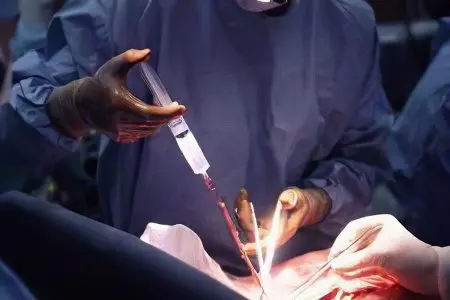Contents
Urethral polyp is a benign formation located on the inner surface of the urethra. The tumor develops from the epithelial layer of the canal wall. Its consistency is soft, subject to the process of vascularization, and therefore often bleeds. The urethral polyp has a stalk, its shape can be round or teardrop-shaped, the color is rich red. In case of injury or infection of the formation, its surface transforms from smooth to ulcerated.
According to statistics, such formations make up no more than 4% of all tumors of the urogenital region in women. In the male population, urethral polyps are diagnosed not so often, which is associated with the peculiarities of its structure. In women, the urethra is much shorter than in men and does not exceed 50 mm in length. The average age when polyps in this area are diagnosed is between 50 and 70 years.
Symptoms of a urethral polyp in women

As for the clinical picture, there are practically no signs of the presence of a tumor in the early stages of its development.
As the mass grows, a woman may begin to experience the following symptoms:
Difficulties with urination. The woman begins to experience a burning sensation and itching during an attempt to empty herself.
The imperative urge to empty the bladder that occurs at night leads to a violation of the rest period.
During the process of urination, the urine stream may deviate in one direction or another, depending on where the polyp is located.
A woman may suffer from partial urinary incontinence. That is, it is released with a strong cough, when the organ is filled, with laughter.
Blood may be visible in the secreted fluid, which is due to the fact that polyposis growths have their own blood vessels. The surface of the tumor is easily injured and begins to bleed. Allocations can be both single and constant, with an abundant release of blood.
Infravesical obstruction is another sign of polyposis growth in the urethra of a woman. In the initial stages, the muscle thickens, and urine comes out due to increased pressure. As the compensatory properties of the muscle are lost, and the tumor continues to grow, the walls of the bladder itself, the ureters and renal pelvis are stretched. As a result, pyelonephritis develops, which requires immediate medical attention.
During intimacy, a woman may experience pain, and after her, blood appears from the urethra.
When ascending cystitis is attached, each attempt to void will cause pain, urination becomes more frequent, and purulent discharge from the canal may appear. The urine itself acquires a dark color (in the presence of blood impurities) and an unpleasant odor (with a purulent infection).
However, such symptoms occur only when the tumor reaches an impressive size. When it is small, it is quite problematic to make a diagnosis, since the polyp does not give almost any symptoms.
Causes of a urethral polyp in women
There are certain factors that can trigger the growth of education, among them:
Prolonged chronic urethritis, in which the walls of the channel that removes urine become inflamed. The inflamed tissue seeks to suppress the pathological process by increasing its own area and begins to grow, resulting in the formation of a tumor.
Hormonal disorder of the functioning of the ovaries.
Disturbances in the work of the endocrine gland, progressive diabetes mellitus.
Cervicitis and colpitis, in which the secreted leucorrhea contributes to the constant irritation of the woman’s urethra.
Injury to the blood vessels of the urethra. They can be obtained during examination or treatment of the bladder, due to chronic constipation, during childbirth.
Sexually transmitted infections. Chlamydia, gonorrhea, ureaplasmosis, trichomoniasis, genital herpes can provoke the formation of a polyp. Often papillomavirus infection becomes a provocateur of growths.
Hormonal changes that occur in a woman’s body as she ages. In this case, we are talking about menopause and postmenopausal period. Therefore, an indirect factor influencing the possible increase in education is age over 50 years.
A prerequisite for tumor growth can be pelvic fractures and diseases of the gastrointestinal tract.
Why are urethral polyps dangerous?

If you ignore the polypous growth in the urethra, then this poses a certain danger to the health of a woman.
The risks are as follows:
development of hematuria. Moreover, both micro- and macrohematuria can occur. Constant blood loss can lead to the development of anemia. In addition, tamponade of the urinary canal with a blood clot may occur. In this case, the patient will need emergency medical attention.
Development of cystitis. The presence of a pathological formation in the urethra makes the bladder more vulnerable and susceptible to various infections.
development of pyelonephritis. The disease can begin as a result of infection along the ascending path to the kidneys. This occurs against the background of cystitis, or against the background of stagnation of urine due to the impossibility of emptying.
Infravesical obstruction, which manifests itself in the inability to empty the bladder, since the polyp completely blocks the urinary canal.
Malignization of education. The degeneration of the tumor is quite rare, however, such a danger cannot be ruled out. Therefore, regardless of the size of the existing formation, its removal is necessary.
Treatment of urethral polyps in women
There is no conservative treatment for a polyp located in a woman’s urethra. Therefore, if such a formation is detected, surgical intervention is necessary. There are several ways to eliminate a tumor from a woman’s body.
Cryodestruction
This method of removal is based on the effect of low temperatures on the tumor. If it is located on the outside of the canal, then the use of a ureteroscope is not required.
The procedure does not require general anesthesia, only local anesthesia is sufficient. As a rule, surgery does not take more than 10 minutes. During the cooling process, the liquid in the tumor turns into ice, the vital activity of the cells is disrupted, and it dies.
Among the advantages of this method of getting rid of the urethral polyp:
The necrotic area does not bleed.
At the site of attachment of the polyp, there will be no scars and scars, which in the future will not lead to problems with urination.
The procedure is painless and does not require general anesthesia.
No sutures are required at the treatment site.
After the intervention, no hospitalization is required.
Electrocoagulation
This method of getting rid of the polyp of the urethra is based on the use of electric current. In this case, the doctor is able to control the depth of exposure, which avoids injury to healthy tissues. The procedure does not require the introduction of the patient into a state of general anesthesia, as it is practically painless.
However, this method of removing polyposis growths cannot be used if there are blood clotting disorders, the formation is large or malignant. If there is an inflammatory process in the body, it should first be eliminated.
Radio wave method for removing education
At the same time, the formation is affected by radio wave radiation, which contributes to the destruction of pathological tissues. Polyposis growth is removed in layers, which minimizes the risk of damage to healthy tissues. After such an intervention, there are also no scars and scars, and the recovery period is significantly reduced.
Wedge excision of education

This procedure is appropriate for use if the formation has an impressive size. After excision, several stitches will be required. The operation requires the introduction of general anesthesia. A woman will need to spend a maximum of 2 days in the hospital. The operation itself is short in time and does not take more than 20 minutes.
During the procedure, a section of the external opening of the canal in the form of a triangle will be removed. Together with this site, the tumor is eliminated. For fixation, self-absorbable threads are used. For the next 24 hours, a drain is inserted into the bladder. The removed tissues are sent for further histological examination, which will determine the presence of atypical cells. If there is a risk of narrowing of the urethra, doctors perform its expansion using special bougie.
After the operation, you will need to follow a special diet for some time. It consists in excluding from food foods that irritate the urethral mucosa. Therefore, it is worth abandoning sour, salty, spicy foods and drinks. Alcohol is completely banned.
Which doctor to contact?
Regardless of the location of the polyposis growth in the urethra of a woman, it is subject to prompt removal. After surgery has been performed, a regular examination by a urologist is necessary. You should visit the doctor at least once every six months. This must be done in order to prevent recurrence of the disease.
If the polyposis growth was provoked by existing infectious diseases, then they must be eliminated, otherwise it will not be possible to achieve a stable remission. Treatment is prescribed only by a doctor, based on the etiology of the infection. As a rule, the prognosis for recovery is favorable if the tumor was excised radically. This gives an unequivocal guarantee that the woman will not have a relapse in the future.
As for other preventive measures, it should be regularly observed not only by a urologist, but also by a gynecologist. Timely disposal of infections and normalization of hormonal levels is a guarantee that polyposis growths in the urethra will not reappear. It is equally important to avoid injury to the urethra and use a condom during intercourse.









